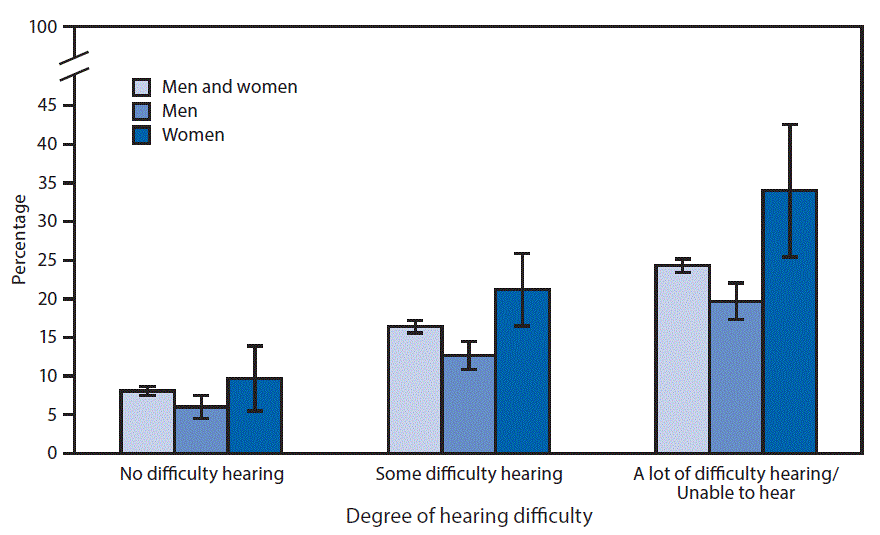QuickStats: Percentage* of Adults Aged ≥45 Years Who Found It Very Difficult or Were Unable to Go Shopping or Attend Movies or Sporting Events,† by Degree of Hearing Difficulty§ and Sex — National Health Interview Survey,¶ United States, 2014–2015
Weekly / February 10, 2017 / 66(5);150

* With 95% confidence intervals indicated with error bars.
† Based on a question that asked “By yourself, and without using any special equipment (such as a cane or wheelchair), how difficult is it for you to go out to things like shopping, movies, or sporting events?” Response categories consisted of “not at all difficult,” “only a little difficult,” “somewhat difficult,” “very difficult,” “can’t do at all,” or “do not do this activity.” For this figure, response categories “very difficult” and “can’t do at all” are combined.
§ Based on a question that asked “Do you have difficulty hearing, even when using a hearing aid? Would you say no difficulty, some difficulty, a lot of difficulty, or are you unable to do this?” Response categories “a lot of difficulty” and “unable to do this” are combined for this figure.
¶ Estimates are based on household interviews of a sample of the civilian, noninstitutionalized U.S. population, are shown for a sample of adults aged ≥45 years, and are age-adjusted to the projected 2000 U.S. population as the standard population using three age groups: 45–64, 65–74, and ≥75 years.
During 2014–2015, adults aged ≥45 years were more likely to find it difficult or be unable to go shopping or go to movies or sporting events as hearing difficulties increased (even with the use of a hearing aid), from 8.1% among those with no difficulty hearing to 16.4% among those with some difficulty hearing, and to 24.3% among those with a lot of difficulty hearing or who were unable to hear. This relationship was found for both men and women. Women were more likely than men to report limitations in these activities at each level of hearing difficulty.
Source: National Health Interview Survey, 2014–2015. https://www.cdc.gov/nchs/nhis/index.htm.
Reported by: Debra L. Blackwell, PhD, DBlackwell@cdc.gov, 301-458-4103; Maria A. Villarroel, PhD.
Suggested citation for this article: QuickStats: Percentage of Adults Aged ≥45 Years Who Found It Very Difficult or Were Unable to Go Shopping or Attend Movies or Sporting Events, by Degree of Hearing Difficulty and Sex — National Health Interview Survey, United States, 2014–2015. MMWR Morb Mortal Wkly Rep 2017;66:150. DOI: http://dx.doi.org/10.15585/mmwr.mm6605a7.
Use of trade names and commercial sources is for identification only and does not imply endorsement by the U.S. Department of
Health and Human Services.
References to non-CDC sites on the Internet are
provided as a service to MMWR readers and do not constitute or imply
endorsement of these organizations or their programs by CDC or the U.S.
Department of Health and Human Services. CDC is not responsible for the content
of pages found at these sites. URL addresses listed in MMWR were current as of
the date of publication.
All HTML versions of MMWR articles are generated from final proofs through an automated process. This conversion might result in character translation or format errors in the HTML version. Users are referred to the electronic PDF version (https://www.cdc.gov/mmwr) and/or the original MMWR paper copy for printable versions of official text, figures, and tables.
Questions or messages regarding errors in formatting should be addressed to mmwrq@cdc.gov.
- Page last reviewed: February 9, 2017
- Page last updated: February 9, 2017
- Content source:


 ShareCompartir
ShareCompartir